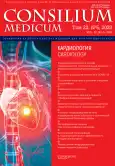Management of patients with chronic heart failure and diabetes mellitus from the standpoint of modern recommendations and in real clinical practice
- Authors: Reznik E.V.1, Lazarev V.A.1, Kalova M.R.2,1, Nikitin I.G.1,3
-
Affiliations:
- Pirogov Russian National Research Medical University
- Buyanov City Clinical Hospital
- National Medical Research Center "Treatment and rehabilitation center"
- Issue: Vol 22, No 5 (2020)
- Pages: 50-56
- Section: Articles
- URL: https://journals.rcsi.science/2075-1753/article/view/95273
- DOI: https://doi.org/10.26442/20751753.2020.5.200198
- ID: 95273
Cite item
Full Text
Abstract
Full Text
##article.viewOnOriginalSite##About the authors
Elena V. Reznik
Pirogov Russian National Research Medical University
Email: elenaresnik@gmail.com
д-р мед. наук, проф. каф. госпитальной терапии
Vladimir A. Lazarev
Pirogov Russian National Research Medical Universityаспирант каф. госпитальной терапии
Marina R. Kalova
Buyanov City Clinical Hospital; Pirogov Russian National Research Medical Universityврач ГБУЗ «ГКБ им. В.М. Буянова», аспирант каф. госпитальной терапии
Igor G. Nikitin
Pirogov Russian National Research Medical University; National Medical Research Center "Treatment and rehabilitation center"д-р мед. наук, проф., зав. каф. госпитальной терапии
References
- Vos T, Abajobir AA, Abate KH et al. Global, regional, and national incidence, prevalence, and years lived with disability for 328 diseases and injuries for 195 countries, 1990-2016: a systematic analysis for the Global Burden of Disease Study 2016. Lancet 2017; 390 (10100): 1211-59. doi: 10.1016/s0140-6736(17)32154-2
- Мареев В.Ю., Фомин И.В., Агеев Ф.Т. и др. Клинические рекомендации. Профилактика, диагностика и лечение хронической сердечной недостаточности (и острой декомпенсации). 2018.
- Cho NM, Kirigia J, Ogurtsova K et al. IDF Diabetes Atlas: Global estimates for the prevalence of diabetes for 2015 and 2040. Diabet Res Clin Pract 2017; 128: 40-50.
- Починка И.Г. Сахарный диабет 2-го типа и хроническая сердечная недостаточность - «несладкая парочка». Мед. альманах. 2017; 6: 103-18.
- Seferovic PM, Ponikowski P, Anker SD et al. Clinical practice update on heart failure 2019: pharmacotherapy, procedures, devices and patient management. An expert consensus meeting report of the Heart Failure Association of the European Society of Cardiology. Eur J Heart Fail 2019. doi: 10.1002/ejhf.1531
- Ponikowski P, Voors AA, Anker SD et al. 2016 ESC Guidelines for the diagnosis and treatment of acute and chronic heart failure: The Task Force for the diagnosis and treatment of acute and chronic heart failure of the European Society of Cardiology (ESC) Developed with the special contribution of the Heart Failure Association (HFA) of the ESC. Eur Heart J 2016; 37 (27): 2129-200. doi: 10.1093/eurheartj/ehw128
- Мареев В.Ю., Фомин И.В., Агеев Ф.Т. и др. Клинические рекомендации ОССН-РКО-РНМОТ. Сердечная недостаточность: хроническая (ХСН) и острая декомпенсированная (ОДСН). Диагностика, профилактика и лечение. Кардиология. 2018; с. 8-164. doi: 10.18087/cardio.2475
- Мареев В.Ю., Агеев Ф.Т., Арутюнов Г.П. и др. Национальные рекомендации ОССН, РКО и РНМОТ по диагностике и лечению ХСН (четвертый пересмотр). Сердечная недостаточность. 2013; с. 379-472.
- Моисеев В.С., Мухин Н.А., Смирнов А.В и др. Сердечно-сосудистый риск и хроническая болезнь почек: стратегии кардио-нефропротекции. Рос. кардиологический журн. 2014; с. 7-37.
- Seferovic PM, Petrie MC, Filippatos GS et al. Type 2 diabetes mellitus and heart failure: a position statement from the Heart Failure Association of the European Society of Cardiology. Eur J Heart Fail 2018; 20 (5): 853-72. doi: 10.15829/1560-4071-2014-8-7-37
- Лапина Ю.В., Нарусов О.Ю., Мареев В.Ю и др. Эффективность и безопасность применения метформина у больных ХСН и СД типа 2. Результаты исследования «Рациональная Эффективная многокомпонентная терапия в борьбе с сахарным диабетом у больных с ХСН» (РЭМБО-СД ХСН). Кардиология. 2008; 48 (3): 50-8.
- Арутюнов А.Г., Рылова А.К., Арутюнов Г.П. Регистр госпитализированных пациентов с декомпенсацией кровообращения (Павловский регистр). Сообщение 1. Современная клиническая характеристика пациента с декомпенсацией кровообращения. Клинические фенотипы пациентов. Сердечная Недостаточность. 2014; 82 (1): 23-31.
- Фомин И.В. Хроническая сердечная недостаточность в Российской Федерации: что сегодня мы знаем и что должны делать. Рос. кардиологический журн. 2016; 8 (136): 7-13. doi: 10.15829/1560-4071-2016-8-7-13
- Ребров А.П., Кошелева Н.А. Влияние терапевтического обучения и активного амбулаторного ведения пациентов с ХСН на их клиническое состояние и сердечно-сосудистые осложнения (трехлетнее наблюдение). Рациональная фармакотерапия в кардиологии. 2011; 7 (3): 27587. doi: 10.20996/1819-6446-2011-7-3-275-287
- Sato T, Yamauchi H, Suzuki S et al. The Prognositic Significance of Serial Renal Function Measurements in Chronic Heart Failure. J Gen Practice 2014; 2 (3): 1-6. doi: 10.4172/2329-9126.1000156
- Nieminen MS, Brutsaert D, Dickstein K et al. EuroHeart Failure Survey II (EHFS II): a survey on hospitalized acute heart failure patients: description of population. Eur Heart J 2006; 27 (22): 272536. doi: 10.1093/eurheartj/ehl193
Supplementary files






